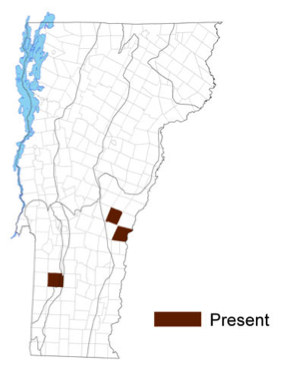|
Resident Conservation Status North American Range |
The true status of this prairie butterfly in Vermont is unknown. The last known Regal Fritillary was a female collected on 17 July 1941 by O.M. Calloway in Pomfret, Vermont (Grehan 1995). We found the specimen in the Peabody Museum of Natural History collection. It was originally in the Dartmouth College collections. We also uncovered two males and a female collected on 14 July 1939 in Dorset in the Peabody collection and three specimens from North Hartland 1894 and 1899, (exact dates unknown) in the Hartland Nature Club collection. Reasons for its decline and eventual extirpation from New England and other areas in the East are not entirely clear. Habitat destruction, changes in land management practices, alien insect parasites, pesticides, or perhaps a combination of stresses have been suggested, but evidence for any are few. Currently, only two Eastern populations remain in Pennsylvania and Western Virginia. Recent genetic studies suggest that the eastern population are relatively distinct and may warrant designation as a separate race (Williams et al. 2003).
Identification
Upperside of forewing bright red-orange with black markings. Upperside of hindwing black with postmedian row of white spots; submarginal row of spots is orange in male and white in female.
Flight
Massachusetts flight was from late June (much later on the islands) to the third week in September, peaking from mid July to early September when both males and females were flying. Only two historic records with dates for Vermont: 14 and 17 July.
Distribution and Habitat
In Massachusetts Regal Fritillary seems to have preferred extensive open areas with a combination of wetlands and upland fields containing an abundance of nectaring plants. It is not known if Regal Fritillary was present in pre-colonial Vermont, which was over 90% forested. But, by the late 1890s, the time of the earliest known records, Vermont was generally a pastoral landscape with only about 35% forest cover (Foster et al. 2010). By 1941 when the last Regal Fritillary was recorded in Vermont, forest cover had nearly doubled, covering abandoned farmlands. This trend has continued during the past 60 years. Approximately 60 percent of Vermont’s hay fields, pasture lands and other open grasslands were lost to succession and sprawl development.






